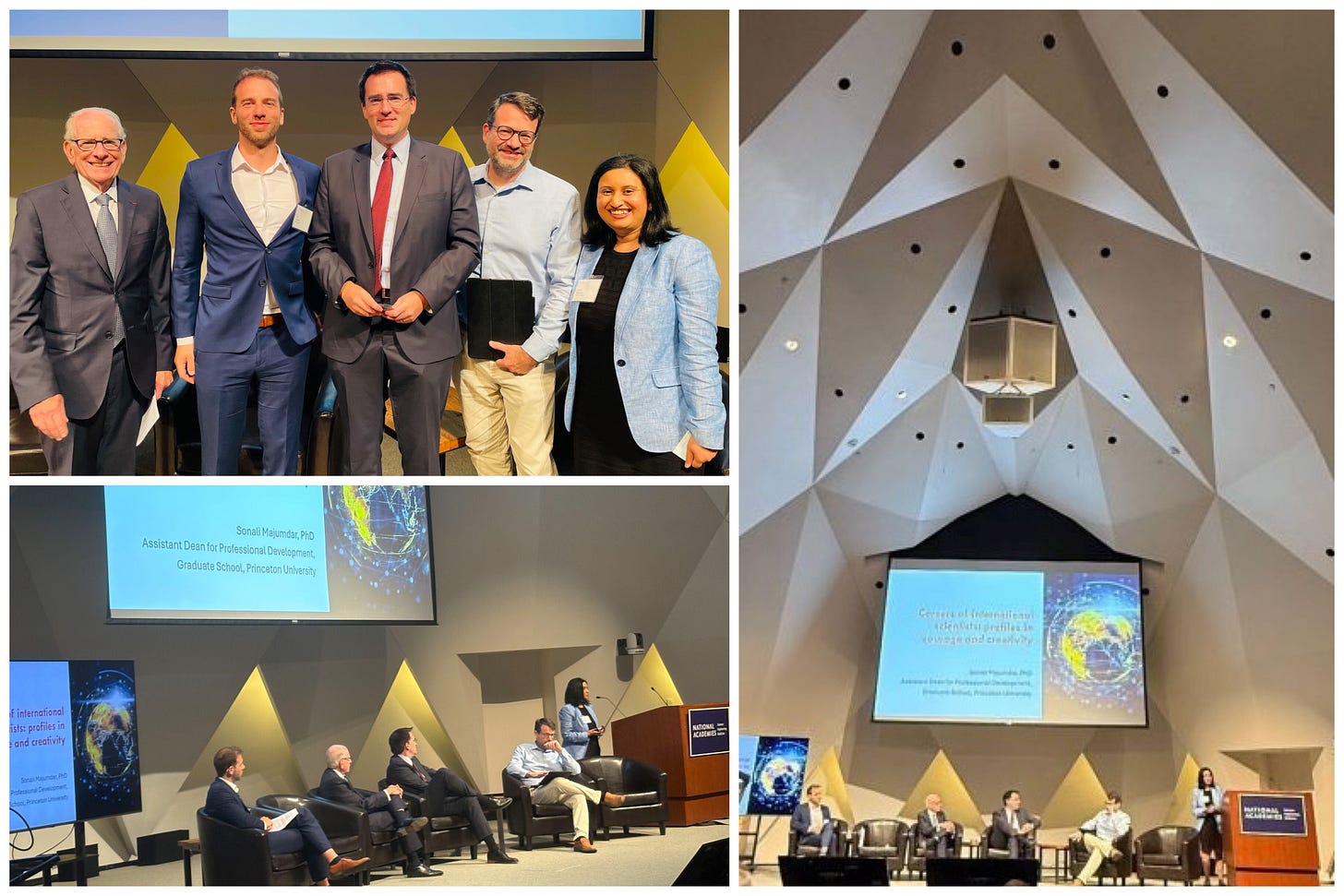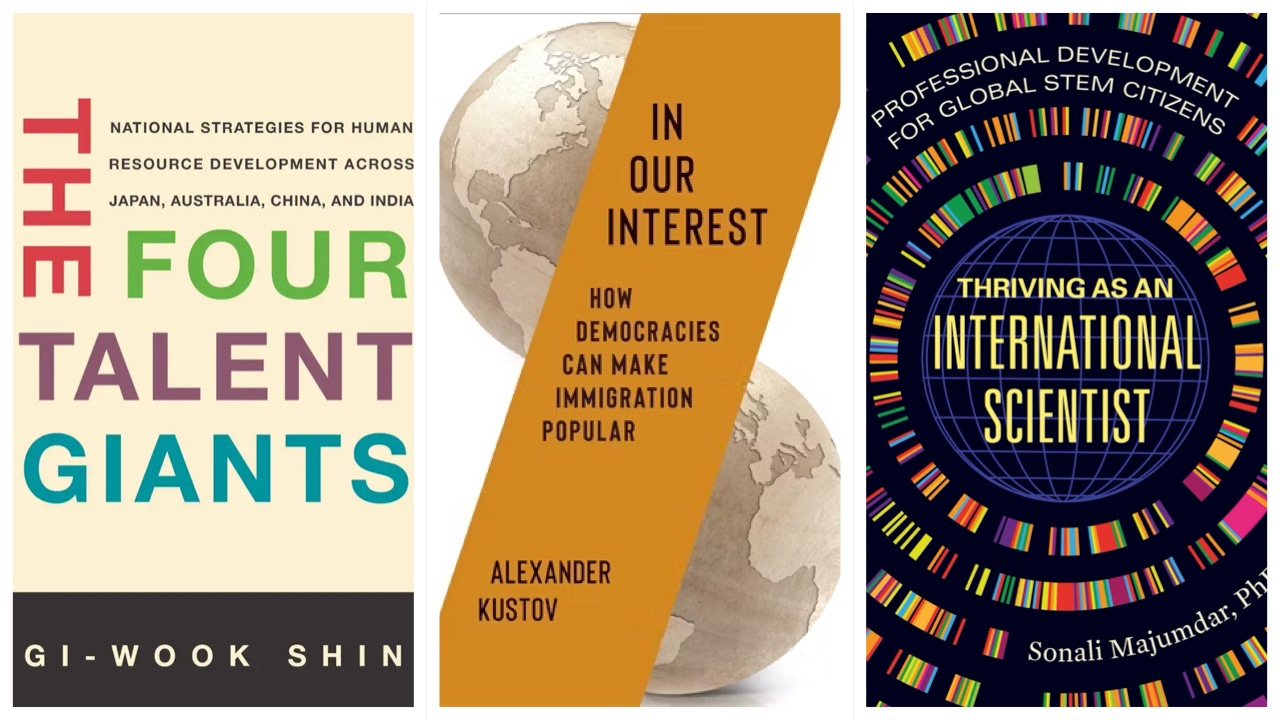At this week's National Academies summit on Reimagining STEMM Graduate Education and Postdoctoral Career Development, I had the privilege of moderating a panel that tackled a question both simple and profound:
What if international students and postdoctoral scholars stopped coming to the United States?
The conversation brought together four distinct, powerful perspectives that illuminated the current moment from every angle:
economic: Michael A. Clemens (George Mason University),
historical: Allan Goodman (Institute of International Education),
institutional: Sonali Majumdar (Princeton University), and
personal: Tim Kodalle (Berkeley Lab).
What emerged was a complex portrait of a system under immense strain, a nation at a crossroads, and the brilliant individuals navigating the uncertainty.
This is not a theoretical exercise.
As I laid out at the start of the discussion, there are intensifying efforts that threaten the very pathways allowing global talent to study, train, and contribute to the American scientific enterprise.
The new USCIS Director, sworn in July 18th, has vowed to eliminate Optional Practical Training (OPT), the program that currently allows 200,000 recent international graduates to gain work experience for 1 to 3 years after graduation.
Concurrently, a late-June proposal from the Department of Homeland Security (DHS) seeks to eliminate "duration of status" for international students, replacing the current policy with fixed terms that would require students to apply for extensions and risk being forced to leave the US before finishing their degrees.
Another DHS proposal, submitted July 17th, aims to replace the random H-1B visa lottery with a salary-based selection process, which would heavily favor high-wage earners and disproportionately impact most recent graduates.
Here is a summary of the conversation as I experienced it: a narrative of warnings, counter-arguments, lived strategies, and unresolved tensions.
The Economic Alarm Bell: A "$400 Billion Hole"
Michael A. Clemens, Professor of Economics at George Mason University, presented a paper commissioned by the National Academies, "Brain Freeze How Restrictions on International Students Shape the STEM Workforce and Economic Growth in the US". Since 2000, foreign-born workers have accounted for 62% of the growth among employed STEM workers with PhDs.
Today, foreign nationals who graduated from U.S. universities make up 34.6% of the current high-skill STEM workforce with a Ph.D. Clements’s modeling suggests that a one-third decline in these students could trigger a 6.2% drop in the employed STEM workforce, resulting in a loss of $220 billion to $439 billion per year after a decade.
Crucially, he highlighted strong evidence that counters the myth that international students take spots from domestic ones. Outside a few elite, slot-limited programs, the economic literature shows the opposite: increased in-state enrollment and lower tuition prices, thereby creating more opportunities for domestic students.
Clements's warning was clear: the current moment is different from past disruptions like 9/11 because it targets the "front door"—OPT and H-1B visas, the primary pathways from a U.S. degree to the U.S. workforce.
A Historical Perspective: America’s Enduring Appeal
Offering a more optimistic counterpoint, Allan Goodman, president emeritus of the Institute of International Education (IIE), drew on 400 years of history to argue for the U.S. system's enduring resilience. He reminded us that a dependence on international scholars in all fields is in America's DNA.
He argued that, unlike in other nations, U.S. universities are largely independent, with their own "foreign policies" and admissions standards. This autonomy has made the U.S. a beacon for centuries. Moreover, he pointed out that since the Second World War, the number of international students has declined in only four years, with most drops being small and temporary. Finally, he noted that the U.S. has immense room to grow. While countries like the U.K. and Australia are approaching 25–30% international-student enrollment, the U.S. sits at around 6%.
That said, he conceded that historical resilience is not immunity and that these "natural advantages" can corrode quickly when policy unpredictability mounts.
Navigating the Labyrinth: The Lived Experience of Global Scientists
The conversation then shifted from the macro to focusing on the lived experiences of those navigating this system. Sonali Majumdar, an Assistant Dean for Professional Development, GradFUTURES, at Princeton University and author of the forthcoming book Thriving as an International Scientist: Professional Development for Global STEM Citizens, grounded the debate in the realities of building a career.
Sharing her own 17-year journey from PhD student to green-card holder, Sonali highlighted the immense resilience required. She outlined three key strategies international scientists now employ:
Proactive Portfolio Building: Strategically building a profile during their PhD or postdoc to become competitive for a green card early.
Creative Career Pivots: Finding roles in adjacent fields—like a scientist's taking a global-health-policy research job at an academic center—to stay aligned with their goals while satisfying visa constraints.
Going Global: A growing number, unwilling to wait, are leveraging their world-class U.S. training to take senior roles at multinational companies and universities in countries like Switzerland and Japan.
Her closing question was a challenge to us all: The world is waiting to recruit the talent trained in the U.S. Does the U.S. want to retain these scientists?
The Postdoc's Reality: A State of Precarity
Finally, Tim Kodalle, a postdoctoral fellow at Berkeley Lab, gave us a firsthand account of the precarity at the heart of the academic pipeline.
He described the shock of receiving very short-term contracts—his first was for six months—and the disorienting experience of being treated as a "student" despite his being a highly trained scientist.
This, he noted, stands in stark contrast to European systems that often provide more stable, long-term research positions outside the traditional tenure-track pressure cooker. His experience illuminated a fundamental disconnect: the system relies on the labor of postdocs but fails to provide them with the stability and professional respect they deserve.
Summer Reading and Final Thoughts
This summer, I’ve been reading some excellent books that place this week’s panel conversation in a broader global context:
Alexander Kustov’s In Our Interest: How Democracies Can Make Immigration Popular (Columbia University Press), and
Gi-Wook Shin’s The Four Talent Giants: National Strategies for Human Resource Development Across Japan, Australia, China, and India by Gi-Wook Shin (Stanford University Press).
(And I have pre-ordered panelist Sonali Majumdar's Thriving as an International Scientist to read this fall, and I plan to interview her for a video podcast on this Substack, so stay tuned!)
For decades, the American scientific enterprise has operated on the assumption that U.S. universities are the world's default destination for ambitious minds. Allan Goodman’s historical perspective reminds us that the U.S. higher-education system has weathered storms before.
Kustov's research offers a powerful explanation for the central challenge identified by the panel: the failure of compelling data to shift a hostile policy narrative. His work argues that public support for immigration is rarely won through appeals to altruism or abstract economic benefits. Instead, it is built on policies that are "demonstrably beneficial" to the national interest in ways that voters can see and understand.
Meanwhile, Shin’s cross-national comparative study highlights how countries deliberately manage their “talent portfolio” — not as a passive by-product of higher-education policy — but as a conscious balancing of four “Bs” of human capital: brain train (educating domestic citizens), brain gain (attracting foreign talent), brain circulation (encouraging nationals to leave, skill up, and return), and brain linkage (mobilizing an overseas diaspora).
These books turn the panel’s question—“What if international students stop coming to the U.S.?”—into a set of strategic questions:
Will the U.S. keep the primary pathways—OPT and H-1B visas—open for new graduates, or will proposed changes significantly limit or effectively close them?
Will a fixed-term student visa rule create so much uncertainty that it disrupts long-term PhD research and timelines?
What would it take to reform the American postdoctoral position from temporary limbo to a more stable, long-term career pathway that reflects the strengths of European models?
How can universities and their allies reclaim the narrative? The panelists agreed that data alone is not enough.
Current policies are revealing a critical vulnerability in the U.S. system: its historic reliance on attracting global talent by default rather than by design. Yet, as the poet Friedrich Hölderlin wrote, "But where the danger is, also grows the saving power."
This critical moment demands a talent mobility strategy guided by evidence-based insights—not merely to patch a failing system, but to build a more dynamic, intentional, and enduring science ecosystem.
Note: This article reflects my personal summary and reflections on the panel discussion. The opinions and interpretations expressed here are solely my own and should not be attributed to the National Academies of Sciences, Engineering, and Medicine, or to any of the individual panelists.



